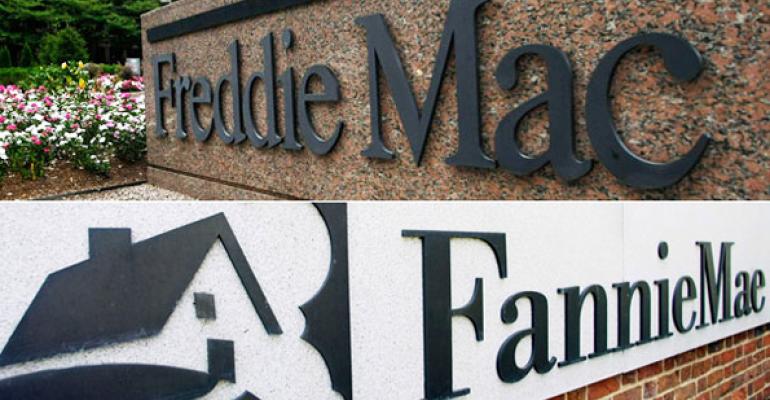Fannie Mae and Freddie Mac expect to break more records this year in their lending on multifamily properties. That means both agencies will have to keep up the tremendously busy pace they set in 2015.
“I think our activity is going to be higher in 2016 than last year,” says John Cannon, senior vice president of multifamily production, sales and marketing for Freddie Mac.
A giant year for Fannie and Freddie
Freddie Mac lent $47 billion to apartment properties in 2015, up more than two thirds compared to the year before. Fannie Mae lent $42 billion. Both far exceeded the $30 billion limit set on their multifamily lending by their federal regulator, the Federal Housing Finance Administration (FHFA). Since the government seized Fannie Mae and Freddie Mac during the financial crisis, FHFA has set limits on their lending activities, though those limits loosened in the spring of 2015. Lending to affordable housing properties and “workforce” housing properties no longer counts towards their $30 billion limits.
The change allowed Fannie Mae and Freddie Mac to serve very strong demand for loans in the multifamily sector. That booming business should continue in 2016, though at a slower rate of growth. “It wouldn’t surprise me if one or both hit $50 billion in 2016,” says a source from commercial real estate services firm JLL.
Strong demand for loans was the main reason that Fannie Mae and Freddie Mac lent so much in 2015.
“There was just an incredible amount of transactions, including both purchase and refinance activity,” says Mitchell W. Kiffe, senior managing director for debt and structured finance with commercial real estate services firm CBRE.
Borrowers needed Fannie Mae and Freddie Mac loans to finance transactions including entire portfolios of apartment properties, like Loan Star Funds’ giant purchase of Home Properties, financed by Freddie Mac. Large, expensive properties like Stuyvesant Town in Manhattan also sold in 2015 with help from $2.7 billion in loan guarantees from Fannie Mae.
In addition, borrowers used Fannie Mae and Freddie Mac loans to refinance apartment mortgages that reached the end of their terms in 2015, including many 10-year loans made at the end of the last real estate boom. That demand will continue as more loans come due in 2016 and 2017. “We know this is going to be a big refinance year,” says Faron Thompson, international director and head of the Atlanta capital markets group for JLL.
Workforce housing
Fannie Mae and Freddie Mac also increased their lending to affordable and workforce housing properties. Freddie Mac’s $47 billion in lending includes more than $17 billion in affordable and workforce housing loans. Fannie Mae’s $42 billion includes more than $12 billion.
“That is an extraordinary amount of uncapped business,” says CBRE’s Kiffe. “They are both obviously focused on workforce and affordable housing.”
New loan products helped the agencies grow their business. Freddie Mac has created two rehab products, each designed to maintain multi-housing stock in the U.S. Borrowers will need to commit anywhere from $10,000 to $50,000 in capital improvements, the majority of which should be for work inside multifamily units.
“The concept is to take a property that hasn’t been updated for 30-plus years and bring it closer to modern standards,” says Freddie Mac’s Cannon.
Fannie Mae is also expanding its loan offerings to help finance affordable and workforce housing. “I’m told Fannie Mae is working on a value-added product as well,” says JLL’s Thompson.
Interest rates inch up for Fannie, Freddie
However, the interest rates that Fannie Mae and Freddie Mac offer inched higher in the second half of 2015. Strain in the bonds markets pushed prices down and yields higher for many types of bonds. For example, the yield on Fannie Mae’s floating-rate mortgage-backed securities rose about 40 basis points to reach a total spread of 85 basis points over Treasury bonds.
“I think credit spreads are going to stay wide,” says CBRE’s Kiffe. “There’s a lot of loan activity out there. There’s not a big competitive push for lenders to cut spreads.”
For permanent financing, agency lenders now offer interest rates averaging around 230 basis points over the yield on 10-year Treasury bonds, or 4.25 percent to 4.50 percent for a typical permanent loan that covers 75 percent of the value of an apartment property.
“We’re seeing Fannie Mae be more competitive in the fixed-rate space,” says JLL’s Thompson. “Freddie Mac’s floating-rate money seems to win over Fannie more times than not.”
Life companies and bank lenders offer strong competition, particularly for lower leverage loans. However, Fannie Mae, Freddie Mac and conduit lenders continue to be the main sources of higher leverage apartment loans. And Fannie Mae and Freddie Mac continue to offer better interest rates, earlier interest rate locks and more certainty of execution than conduits.

